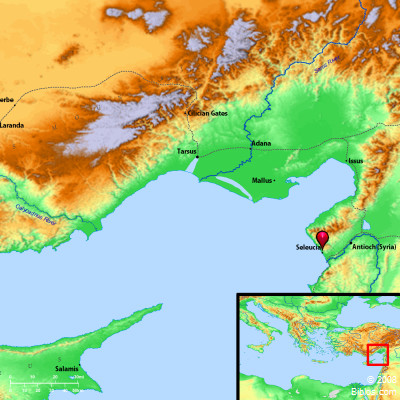Atlas  Seleucia and surrounding region Maps Created using Biblemapper 3.0 Additional data from OpenBible.info You are free to use up to 50 Biblos coprighted maps (small or large) for your website or presentation. Please credit Biblos.com. Occurrences Acts 13:4 So, being sent out by the Holy Spirit, they went down to Seleucia. From there they sailed to Cyprus.Encyclopedia SELEUCIAse-lu'-shi-a (Seleukia): The seaport of Antioch from which it is 16 miles distant. It is situated 5 miles North of the mouth of the Orontes, in the northwestern corner of a fruitful plain at the base of Mt. Rhosus or Pieria, the modern Jebel Musa, a spur of the Amanus Range. Built by Seleucus Nicator (died 280 B.C.) it was one of the Syrian Tetrapolis, the others being Apameia, Laodicea and Antioch. The city was protected by nature on the mountain side, and, being strongly fortified on the South and West, was considered invulnerable and the key to Syria (Strabo 751; Polyb. v.58). It was taken, however, by Ptolemy Euergetes (1 Maccabees 11:8) and remained in his family till 219 B.C., when it was recovered for the Seleucids by Antiochus the Great, who then richly adorned it. Captured again by Ptolemy Philometor in 146 B.C., it remained for a short time in the hands of the Egyptians. Pompey made it a free city in 64 B.C. in return for its energy in resisting Tigranes (Pliny, NH, v.18), and it was then greatly improved by the Romans, so that in the 1st century A.D. it was in a most flourishing condition. SELEUCIA, the seaport of Antioch in Syria, from which it is 16 ms. distant. It is now a small village with ruins and has a large inner harbor with a narrow entrance from the Mediterranean. See Map No. 7. Strong's Greek G4581: SeleukeiaSeleucia, a city of Syria |



